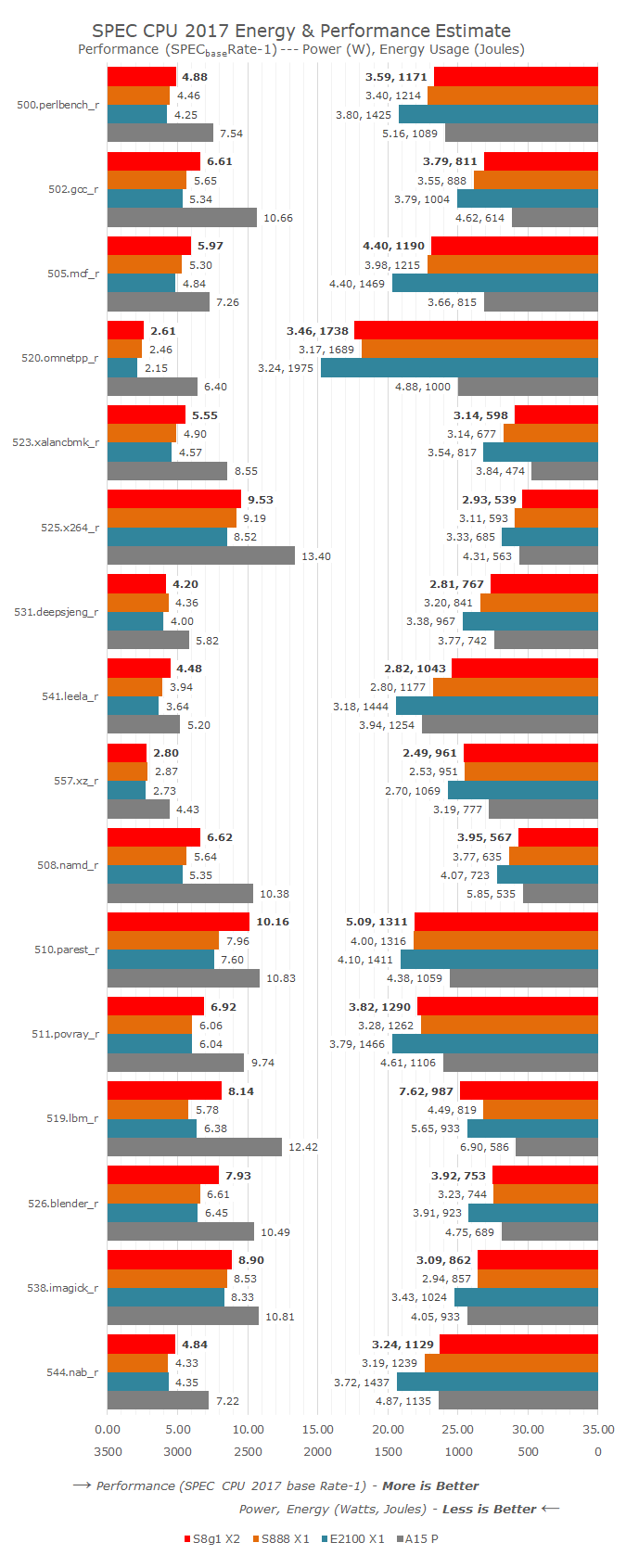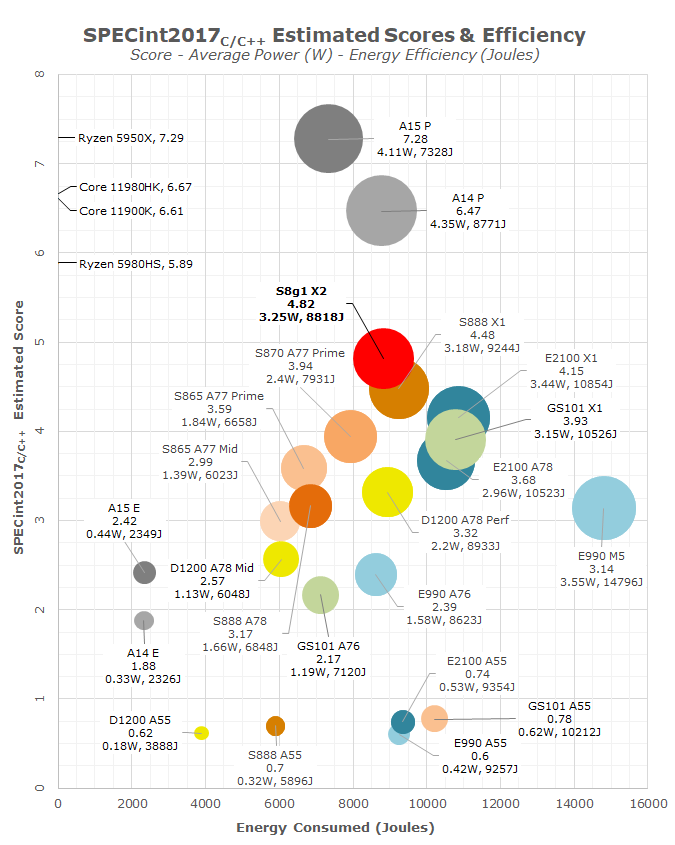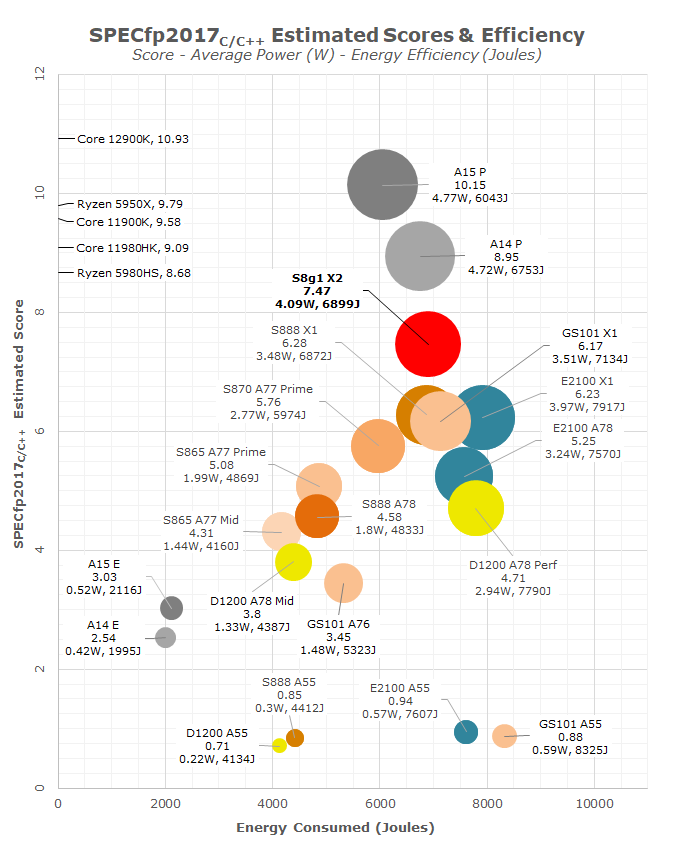The Snapdragon 8 Gen 1 Performance Preview: Sizing Up Cortex-X2
by Dr. Ian Cutress on December 14, 2021 8:00 AM ESTTesting the Cortex-X2: A New Android Flagship Core
Improving on the Cortex-X1 by switching to the Arm v9 architecture and increasing the core resources, both Arm and Qualcomm are keen to promote that the Cortex-X2 offers better performance and responsiveness than previous CPU cores. The small frequency bump from 2.85 GHz to 3.00 GHz will add some of that performance, however the question is always if the new manufacturing process coupled with the frequency increase allows for better power efficiency when running these workloads. Our standard analysis tool here is SPEC2017.
Running through some of these numbers, there are healthy gains to the core, and almost everything has a performance lift.
On the integer side (from 500.perlbench to 557.xr), there are good gains for gcc (+17%), mcf (+13%), xalancbmk (+13%), and leela (+14%), leading to an overall +8% improvement. Most of these integer tests involve cache movement and throughput, and usually gains in sub-tests like gcc can help a wide range of regular user workloads.
Looking at power and energy for the integer benchmarks, we’re seeing the X2 consume more instantaneous power on almost all the tests, but the efficiency is kicking in. That overall 8% performance gain is taking 5% less total energy, but on average requires 2% more peak power.
If we put this core up against all the other performance cores we test, we see that 8% jump in performance for 5% less energy used, and the X2 stands well above the X1 cores of the previous generation, especially those in non-Snapdragon processors. There is still a fundamental step needed to reach the Apple cores, even the previous-generation A14 performance core, which scores 34% higher for the same energy consumed (albeit on average another 34% peak power).
Just on these numbers, Qualcomm’s +20% performance or +30% efficiency doesn’t bare fruit, but the floating point numbers are significantly different.
Several benchmarks in 2017fp are substantially higher on the X2 this generation. +17% on namd for example would point to execution performance increases, but +28% in parest, +41% in lbm and +20% in blender showcases a mix of execution performance and memory performance. Overall we’re seeing +19% performance, which is nearer Qualcomm’s 20% mark. Note that this comes with an almost identical amount of energy consumed relative to the X1 core in the S888, with a difference of just 0.2%.
The major difference however is the average power consumed. For example, our biggest single test gain in 519.lbm is +41%, but where the S888 averages 4.49 watts, the new X2 core averages 7.62 watts. That’s a 70% increase in instantaneous power consumer, and realistically no single core in a modern smartphone should draw that much power. The reason why the power goes this high is because lbm leverages the memory subsystem, especially that 6 MiB L3 cache and relies on the 4 MiB system level cache, all of which consumes power. Overall in the lbm test, the +41% performance costs +20% energy, so efficiency is still +16% in this test. Some of the other tests, such as parest and blender, also follow this pattern.
Comparing against the competition, the X2 core does make a better generation jump when it comes to floating point performance. It will be interesting to see how other processors enable the X2 core, especially MTK’s flagship at slightly higher frequency, on TSMC N4, but also if it has access to a full 14 MiB combination of caches as we suspect, that could bring the power draw during single core use a lot higher. It will be difficult to tease out exactly who wins what where based on implementation vs. process node, but it will be a fun comparison to make when we look purely at the X2 vs. X2 cores.
Unfortunately due to how long SPEC takes to run (1h30 on the X2), we were unable to test on the A710/A510. We’ll have to wait to see when we get a retail unit.













169 Comments
View All Comments
rtho782 - Friday, December 17, 2021 - link
Alex Katouzian is like budget Sylvester Stallone :Dbogamia - Monday, December 20, 2021 - link
Apparently, D9000 has been benchmarked by this Chinese YouTuber (https://youtu.be/1ves1M4Ai-I) and it outperformed the snapdragon 8 gen 1 in all the areas. The performance power watt gap is massive between these two chips. Even in GPU benchmarks, D9000 outperformed the snapdragon equivalent. This is going to be an interesting generation. I wonder what will be the excuses of OEMs to use Qualcomm in the affordable flagship segments .iphonebestgamephone - Monday, December 20, 2021 - link
It looks like things like genshin impact is still more optimized for adreno.ChrisGX - Thursday, December 23, 2021 - link
>>[the D9000] outperformed the snapdragon 8 gen 1 in all the areas<<Not, exactly. The vlogger makes clear that the Adreno GPU in the Snapdragon 8 Gen 1 offers slightly higher performance than the Mali G710 in the D9000 but that the small performance increment comes at a significant cost in power consumption terms. So, while the Mali GPU offers slightly lower performance it is definitely the more energy efficient GPU.
Kangal - Friday, December 24, 2021 - link
Interesting video. Here's the recap:GeekBench 5 (Single-core)
D9000: 1287 score, 3.5 Watts, 368 Efficiency
QC 8g1: 1200 score, 4.2 Watts, 286 Efficiency
QSD 888: 1135 score, 3.8 Watts, 299 Efficiency
GeekBench 5 (Multi-thread)
D9000: 4474 score, 9.8 Watts, 457 Efficiency
QC 8g1: 3810 score, 11.1 Watts, 343 Efficiency
QSD 888: 3753 score, 8.9 Watts, 422 Efficiency
GFXBench Aztec Ruins (High/1440p Offscreen)
D9000: 43 fps, 8.2 Watts, 5.24 Efficiency
QC 8g1: 47 fps, 11.2 Watts, 4.20 Efficiency
QSD 888: 30 fps, 9.0 Watts, 3.34 Efficiency
Genshin Impact (Quality Mode, Initial Performance)
D9000: 60 fps, 6.8 Watts, drops 1.1 Watts, 7 minutes then throttles
QC 8g1: 60 fps, 7.5 Watts, drops 1.2 Watts, 3 min then dips but maintains
QSD 888: 60 fps, 7.5 Watts, drops 1.6 Watts, 6 minutes then throttles
Genshin Impact (Quality Mode, after 15min throttling)
D9000: 48 fps, 5.7 Watts, 8.42 Efficiency, Resolution 1422x640
QC 8g1: 55 fps, 6.3 Watts, 8.73 Efficiency, Resolution 1422x640
QSD 888: 48 fps, 5.9 Watts, 8.14 Efficiency, Resolution 1600x720
ChrisGX - Tuesday, January 4, 2022 - link
Xiaobai's Tech Reviews ( https://www.youtube.com/watch?v=_TyEkQZvAEI ) - a Hong Kong based YouTuber - has come to similar conclusions to the tech vlogger (Geekerwan) that you cite. The benchmark testing conducted by both vloggers seems broader in scope and more careful than the usual fare on YouTube. In both cases the engineering test mules/prototype devices tested were equipped with the latest crop of premium ARM SoCs (that will appear in production Android devices in 2022). The similarity of benchmark results doesn't guarantee the correctness of those results or the completeness of the performance picture drawn, of course, but with independent sources getting very similar results it wouldn't be a shock if production devices follow the evident pattern.Golden Reviewer, a Singapore based tech reviewer/vlogger (posting reviews in English) if anything offers an even more critical account of the SD8 Gen 1 and an account of the D9000 that does indeed credit it as the better chip in most areas. Using a pre-production device in testing he singles out overheating as a serious problem for the SD8 Gen 1.
https://www.youtube.com/watch?v=HO46vmsS61Y
https://www.youtube.com/watch?v=dCYx3K4qjX4
https://www.youtube.com/watch?v=bTW6Z55bEfU
maik80 - Tuesday, January 18, 2022 - link
Fans of android have a mania to use AnTuTu, the owner has already been arrested for fraud in the tests, it has already been confirmed that he received to increase the result. In addition to giving points for the amount of ram memory. it's a jokeqnfw3174 - Thursday, March 31, 2022 - link
Is it finished to test A710/A510? Where can I find the result?yeeeeman - Monday, April 25, 2022 - link
Can we get a follow up on this?